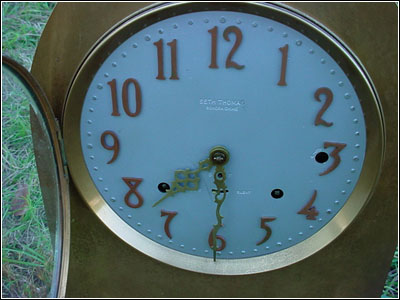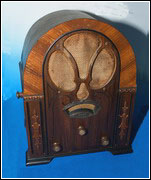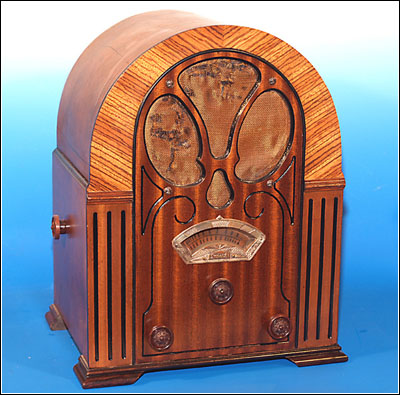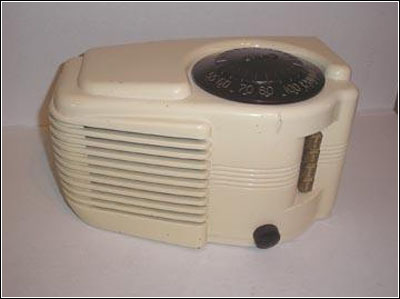Of Old Radios And Related Items--Published Monthly
Sonora -- From Chimes to Radio
"Clear as a Bell"BY RICHARD ARNOLD
WEB EDITION
The focus of this article was first going to be the Sonora Model WAU-243. However, one bit of information led to another, and before he knew it, Richard Arnold was deep into the story of a company with an interesting history in radio. (Editor)
The image of a bell and a slogan "Clear as a Bell" proved to be appropriate no matter what product the Sonora Company was touting throughout its history -- from clocks to phonographs to radios. Beginning in 1908 as the Sonora Chime Company at 5 Cedar St., New York City, the company patented its system of chiming bells to be put into its clocks. These Sonora chime bells, actually shaped like bells, were so very melodious and had such an accurate pitch that they were patented on their manufacture and quality.
Sonora Chime Company started making two-movement chime clocks around 1900. The company made only a few of its own clocks before Seth Thomas acquired the patent rights in 1908.
Seth Thomas's first Sonora chime models appeared in the company's 1909-1910 catalog. These clocks, using the Sonora "nest of bells" chiming mechanism, are highly sought after today. Sonora also made a chime rod mechanism. An example of a Seth Thomas clock with a Sonora chime mechanism is shown in Figure 1.
Figure 1. The face of this Seth Thomas windup clock is marked "Seth Thomas, Sonora chime."The Sonora Phonograph Company
Back around 1910, many companies were trying to get into the manufacturing and selling of one of the hottest items on the market, the phonograph. One of these companies was Sonora, which used "Clear as a Bell" as its slogan, touting the fidelity of its machine's sound reproduction.
The Sonora Chime Company was reincorporated in February of 1913 as the Sonora Phonograph Company by its founder George Brightson. It was located at 78 Reade St., New York City.
An earlier attempt by the Sonora Phonograph Company in 1909 to sell horns and hornless machines made by a Swiss company named Paillard had run into legal problems and went nowhere. Paillard at that time was also a major manufacturer of music boxes.
A company named Presto Products produced the Sonora phonographs. Sonora also bought thousands of its phonograph motors from a Swiss Company named Bawdy.
Sonora was one of the companies that were allowed to exist by the big three (Victor, Edison and Columbia) to avoid threats of a trust suit. Because Sonora had paid a lot of money in royalties on patents held by the big three on a per unit basis, it could only compete with them on their high-end machines.
Figure 4. Sonora exported radios to France, such as this Sonora Model F1.In fact, Sonora ads say, "The Highest Class Talking Machine in the World." The prices ranged from $60 to $2,500. The hardware varied from unit to unit indicating that they were most likely made by various manufactures. The fancy cabinets were Sonora's best selling point, along with its "award-winning magnificent, pure, clear, rich mellow tone." In 1915, the Sonora Phonograph Company won the award for tone at the Panama Pacific Exposition.
Sometime in the middle of 1919, the Sonora Phonograph Company opened an assembly factory in Saginaw, Michigan, and the company headquarters was moved there in the summer of 1927. At that time, Michigan was the center of cabinet production, especially in the Grand Rapids area. Sonora at this time also had a branch in Oakland, California, that later became Magnavox.
Sonora Radio and Television Corp.
During the late 1920s and the Depression years, Sonora had many rough times, including going into receiverships and bankruptcy. The company emerged from bankruptcy on March 10, 1938, under the Articles of Incorporation as the Sonora Radio and Television Corporation.
The new company's corporate offices were located in Room 14108 of the very large Merchandise Mart building in Chicago, Illinois. It was estimated that the gross amount of business that would be transacted during the following year (1939) would be $40,000.
Sonora sales in the year 1940 were $200,000. On a list of 18 companies it was Number 14. It was doing better than Detrola, Farnsworth and Sparks Withington and tied with Wells-Gardner. Then the company moved again in September of 1943 to 325 N. Hoyne Ave., Chicago, Illinois.
I came across a 78 rpm record put out by the Velvetones in 1946-1947 that was released on the Sonora label, shown in Figure 2 (see print version). The label reads, "The Sonora Radio and Television Corporation." The songs are, "It Just ain't Right" and "Reverse the Charges."
Another point of interest here is that if you have a Sears Silvertone radio with the first three numbers of the chassis as #135, that means your radio was made by Sonora.
Figure 6. The French-made Sonora Model F1.The French Connection
In 1923, Sonora phonographs were being sold in two stores in France. The stores, both in Paris, were called "The Innovation" and "Champ."
I found a picture of a Sonora radio factory located at 5 Rue de la Mairie, Paris, France. Actually it was located in a prosperous suburb of Paris called Puteaux. There is a sign in front of the plant that says "L'Amerique Guarantie avec un Sonora Radio" -- you are guaranteed to hear American stations on a Sonora radio. See Figure 3 (see print version).
In 1932, the American Sonora Company exported cathedral-style radios to France. A typical radio is shown in Figure 4. Figure 5 (see print version) shows a French advertisement for Sonora.
In the same year, after about a year or so of gearing up for production, the French Sonora Company, (Sonora SA France), started making a Model F1, the "Puissant," for the French market. This set is shown in Figure 6. Sonora became an important and popular brand in France, and the French company never exported any of its radios to the United States.
There is a new French Sonora website that has all kinds of information, including a lot of color photos of French Sonora radios -- www.radio-sonora.com/index.php. The owner of the site is Mr. Philippe Delmotte.who has been very helpful and has given me permission to use whatever information from his site that I need.
The Canadian Connection
Sonora also did business in Canada. The company called the Sonora Corporation of Canada Ltd. had two addresses: in 1924, the address was in Bridgeburg, Ontario; in 1931, it was 79-181 King Street West, Toronto, Ontario. The company made only 15 models, and In 1932, due to the Depression, moved back to the U. S.
I have talked to Lloyd Swackhammer, author of the book Radios of Canada, who has been very helpful in my Sonora research. Looking for the Canadian Sonora models listed in the schematic books of the Radio College of Canada, Mr. Swackhammer found the following information on Sonora radios made for the years 1929-1933.
Model Year ___Models____ 1929-30 A 40, A 44, 31, 33 1930-31 36, 36A & C38 1931-32 D50, D70 1932-33 S7, S10, S12, 8AW, D90The D90 was also identified as a chassis, and used in the Frasser and Cartier models of Sonora Radios. The 1930-31 Sonora Models C34 and C35 were made for Sonora by the Stewart-Warner Speedometer Corporation of Belleville Ontario, which changed its name in 1931 to the Stewart-Warner Alemite Corp. Ltd., and continued in business for many years.
Sonora Model WAU-243
The Sonora set that piqued my interest in the company is my Model WAU-243, shown in Figure 7 (see print version) and 8. My sales catalog has very good descriptions of Sonora sets. Here is what it says about the Model WAU-243:
"Sonora's special knack for quality and heads-up creative styling is dramatized in this peerless plastic model. You will take a keenest pride of possession in the rare beauty of this original Sonora design. You'll get a listening-lift and everlasting pleasure from that famous "Clear as a Bell" tone. And you'll marvel at the tuning ease of this sensitive performer, whether you bring in your favorite stations by automatic push button, or by fingertip touch of the smooth giant rotor dial. Finally, you'll be pleased as punch with the sensible price of this refreshingly different Sonora."
Figure 8. The Sonora WAU-243 features a large tuning dial on the top of the radio and mechanical push buttons.The Model WAU-243 is an AC-DC superhet ivory plastic table model that sold for $29.75. It tunes the complete standard broadcast band from 535 to 1720 KC, plus police calls. It has push-button tuning for four favorite stations; a built-in "Sonorascope" loop antenna, so that no aerial or ground is needed; a 5-inch dynamic speaker; and an automatic volume control. It is Underwriters approved.
The streamlined, ivory plastic, molded cabinet has a giant maroon rotor dial and a graceful louvered grille. The dimensions are 11.4" x 6.75" x 6.4". The tube complement is one each of the following: 12SA7, 12SK7, 12SQ7, 35L6, and 35Z5. The shipping weight is nine pounds.
Sonora Tubes
Sonora was also putting its name on radio tubes. I found an address for the Sonora Tube Company located at 220 South State Street, Chicago, Illinois. I have come across pictures of blue Arcturus tubes with the Sonora name engraved into the base. According to George H. Fathauer at tubes@qwest.net, Sonora, along with other tube types, had a series of 15V filament tubes that were unique to Sonora radios. They came in boxes printed "Sonora A-C Tubes made especially for Sonora Radio sets." Developed by Arcturus, the tube used a carbon rod for the heater. It had a long thermal time constant allowing operation on AC. Some of the tube numbers were RA-1 and RE-1.
When Sonora Radio and Television Corp went bankrupt in 1929/1930, they owed the Arcturus Tube Company $18,458.
Looking over all of this history, it seems that Sonora Corporation had a rough existence -- moving In and out of receivership a number of times, fighting receiverships, having to sell off assets to make others happy, bankruptcies, big shots stealing money. Finally, on January 1, 1957, the State of Illinois decreed the Sonora Radio & Phonograph Corporation bankrupt again and for the last time. Then on December 23, 1958 a decree -- Number 164184 -- was issued by the State of Illinois dissolving the corporation
Special thanks to the following for providing information included in this article: Philippe Delmotte, France, www.radiosonora.com.php; Lloyd Swakenhammer, author of Radios of Canada; Sonny Clutter, The Radiola Guy, sonny@radiolaguy.com; and all of the radio collectors that I have contacted over the course of this research who have contributed a little bit here and a little bit there. All of these "little bits" helped to put this article together. Now because of a cumulative effort, we know quite a bit more about this elusive company.
References:
Encyclopedia of Chicago
Delmotte, Philippe. www.radiosonora.com.php;
Maclaurin, W. Rupert. Invention and Innovation in the Radio Industry. New York: The MacMillan Co., 1949.
New York Times (Financial), Oct. 23 & 27, 1923.
New York Treasure Chest of Clocks web page
Noteworthy News, September 1999.
The Presto History Page
The Radio Museum: www.Radiomuseum.org.
The Radio and Television Museum, Brian Belanger, Curator.
Radio Trade Builder, Sept. & Dec., 1931
Sonora sales catalog, 1948.
Swackhammer, Lloyd. Radios of Canada. Cheektowago, N.Y.: Hammond Mfg. Co., 2002.
The Vocal Group Harmony Web Site.
(Richard Arnold, P.O. Box 275, Lone Grove, Oklahoma 73443)
Richard Arnold, a frequent contributor to A.R.C., has been collecting radios since 1985. His interest is primarily in cathedrals and 1920s battery sets, and his collection ranges from crystal sets to a 1928 American Bosch in a Pooley cabinet. His prize is the 1932 Jackson Bell Peter Pan featured in the June 1991 A.R.C.
| [Free Sample] [Books, etc., For Sale] [Subscribe to A.R.C./Renew] [Classified Ads] [Auction Prices] [Event Calendar] [Links] [Home] [Issue Archives] [Book Reviews] [Subscription Information] [A.R.C. FAQ] URL = http://www.antiqueradio.com/Apr07_Arnold_Sonora.html Copyright © 1996-2007 by John V. Terrey - For personal use only. Last revised: March 28, 2007. For Customer Assistance please contact ARC@antiqueradio.com or call (866) 371-0512 toll free Pages designed/maintained by Wayward Fluffy Publications
Antique Radio Classified |



